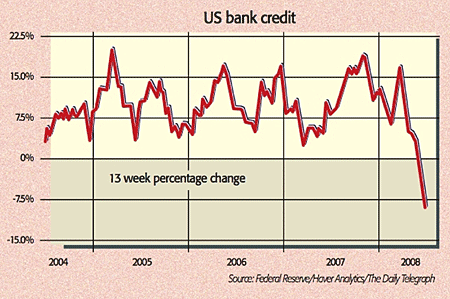
The Bear Stearns rescue merely marked the “end of the beginning” of the credit crisis, says Ruth Sunderland in The Observer. Over the past few days the MSCI world equity index has joined American, British and European indices in bear market territory – a 20% slide from the latest peak – as jitters over the US financial system have intensified. US and UK stocks are at two-and-a half and near three-year lows respectively.
The latest worry has been the fate of mortgage giants Fannie Mae and Freddie Mac, which own, or guarantee, almost half the $12bn US mortgage market.
With worries mounting over their liquidity and solvency as the housing turmoil spreads beyond the subprime segment, and their share prices tanking, the Fed has said it will allow them access to emergency funding and the Treasury will purchase equity from them if necessary. But these stop-gap measures appear to have done little more than highlight the parlous state of the US economy. Nervous investors have shifted their focus to the fate of institutions that are not too big to fail as the housing market and wider economy deteriorate.
Last week, mortgage lender IndyMac was taken over by regulators after suffering a run on deposits. Shares in Washington Mutual, one of the country’s biggest banks, lost 35% on Monday; an index of the biggest US comercial banks is at a 12-year low. Federal authorities have over 90 lenders on a “problem list” – a “death watch” as Gerard Baker puts it in The Times. Even more worrying is that IndyMac wasn’t on the list. According to Gerard Cassidy of RBS Capital Markets, over 300 banks could fail within three years. Phase I of the credit crisis was largely about writedowns of dodgy securities, says Tony Jackson in the FT. Now we’re in phase II: “the travails of ordinary commercial banks”. And this is where the credit crunch “transmits itself to the wider economy”.
John Mauldin on Investorsinsight.com highlights a report by Bridgewater Associates warning of “an avalanche of bad assets”. Around $550bn of corporate liabilities have yet to be written off, Bridgewater estimates, while Alt-A – a step above subprime – and prime mortgage books (much larger than their subprime counterparts) are also vulnerable. The bottom line? Another $1.1trn is likely to be written off by institutions worldwide, taking overall global losses from the credit crisis to $1.6trn. And with banks unlikely to be able to raise much new capital – the obvious rescuers, sovereign wealth funds, have had their fingers burned – losses of the size predicted by Bridgewater are “life-threatening for more than one major institution”, says Mauldin.
More losses imply a further contraction in bank lending, the lifeblood of the economy. Lending at America’s commercial banks fell by an annual rate of 9% in the 13 weeks to mid-June, and Greg Weldon of Weldon’s Money Monitor expects a further drop of around 8% over the next nine months. Gauges of the money supply in America have stagnated and begun to contract over the past quarter, notes Ashworth. What’s more, the latest Fed survey shows banks want to tighten further. Historically, money and credit have only ever contracted during a recession. “Deflation is now the biggest threat.” Note too that growth rates in the money supply have slid in both the eurozone and in Britain.
But despite the increasingly nasty outlook it seems analysts are still in denial. Tom Stevenson in The Daily Telegraph notes that next year earnings are expected to rise by 8.2% in Britain and 20% in America. So reining to unrealistic expectations will be yet another headwind forstocks over the next few months, as Neil Hume notes in the FT. “There is a lot more pain to come.”
The big picture: housing is already nastier than last time
This housing downturn has barely begun, but is already nastier than its early 1990s counterpart. According to Halifax figures, prices last month were down by 8.6% from last June’s level, and there was never a year-on-year drop of more than 7.8% last time. What’s more, prices are already 9% down from last year’s peak, while the Halifax index recorded a 13% top-to-bottom slide last time. With approvals plunging and the mortgage squeeze showing scant sign of easing, the fall is far from over – especially as the economy and the labour market have only just started to deteriorate.